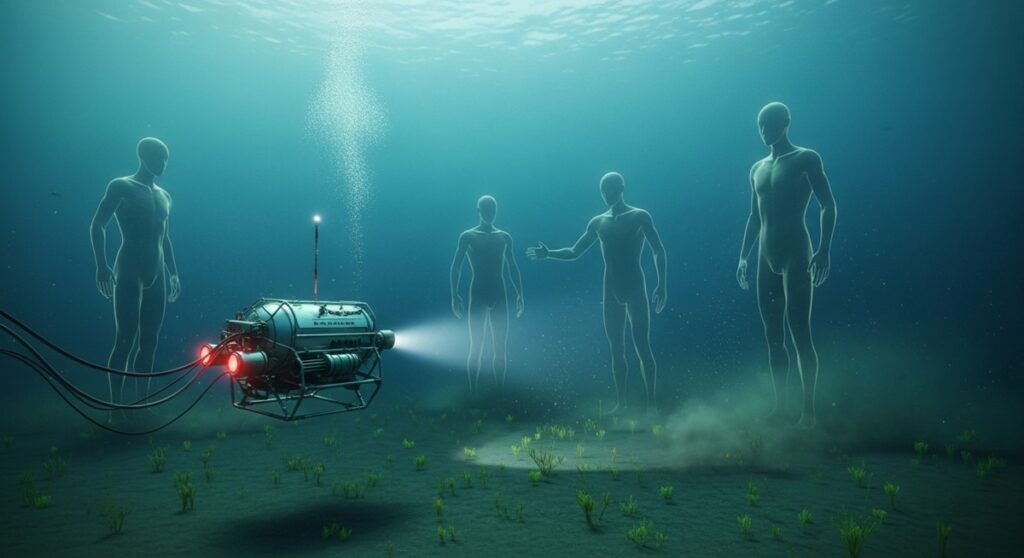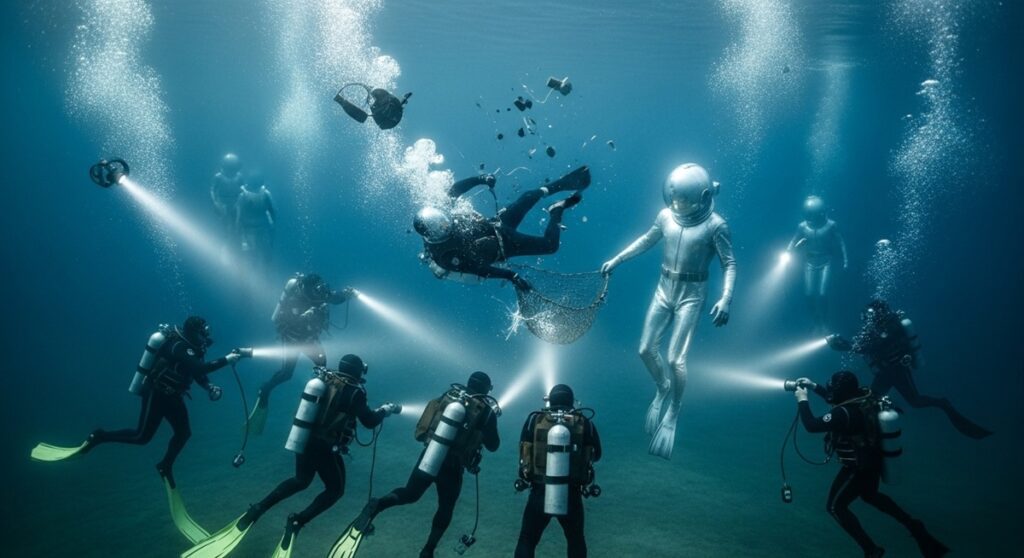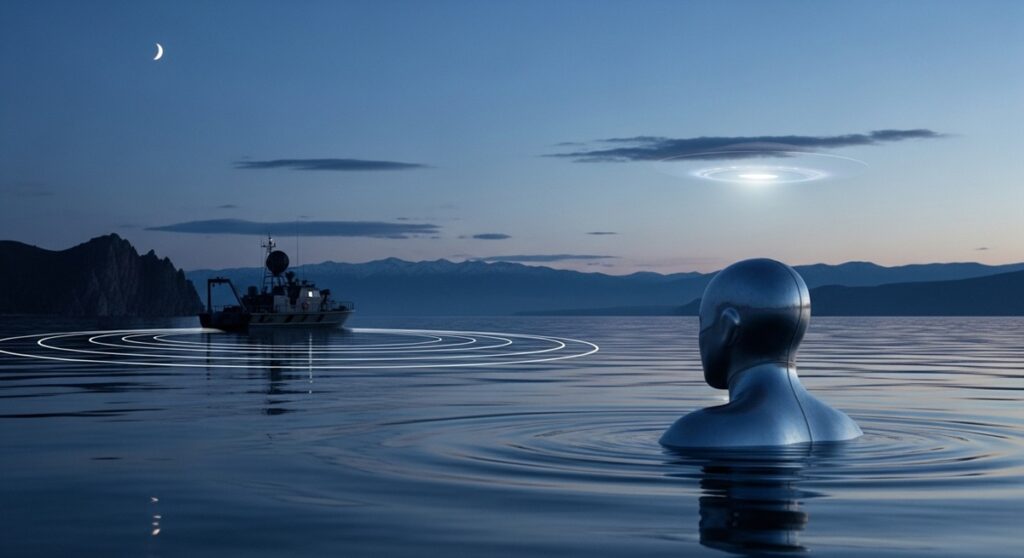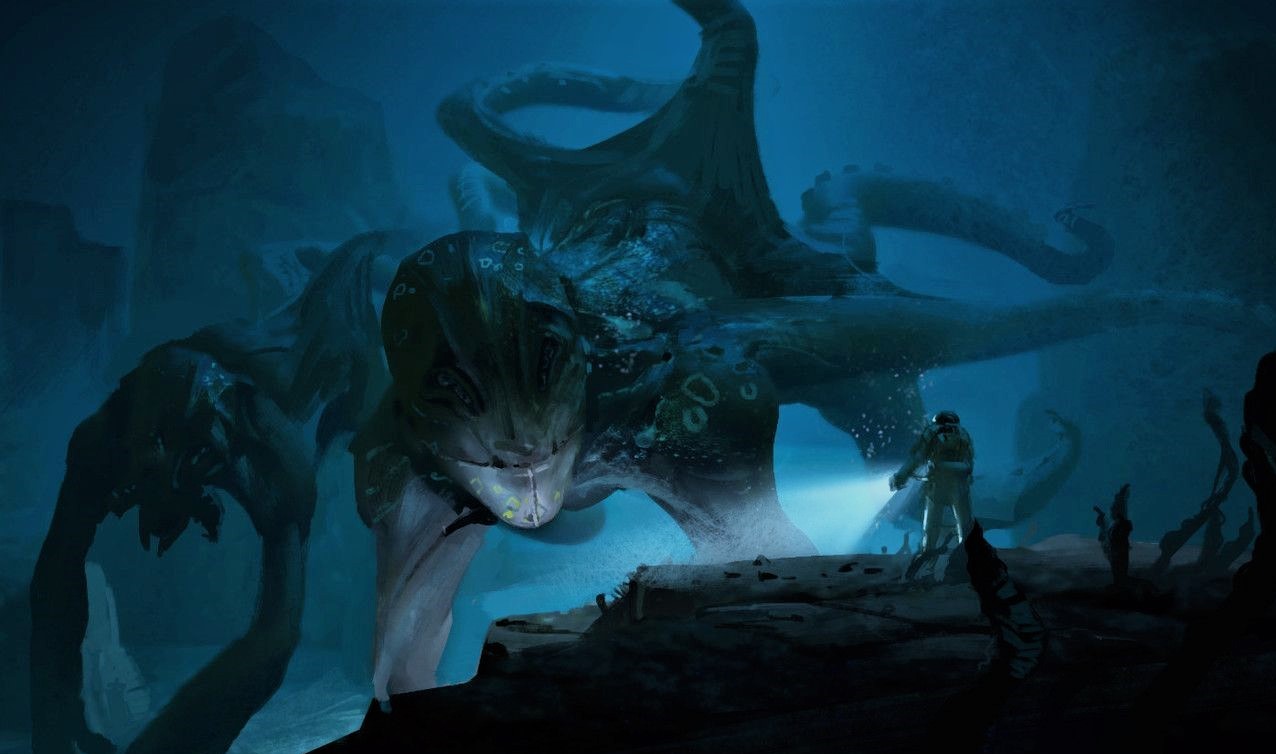Up high in the Tian Shan Mountains of Kyrgyzstan, Lake Issyk-Kul has long captivated travelers, scientists, and mystery enthusiasts alike. This vast, saline body of water, spanning over 6,200 square kilometers and plunging to depths of more than 700 meters, boasts crystal-clear waters, stunning alpine scenery, and a rich history of folklore that blurs the line between myth and reality. But beneath its serene surface lies a persistent enigma: reports of massive, humanoid figures gliding through the depths, often described as three-meter-tall “swimmers” in shimmering suits.
These sightings, spanning nearly a century, have fueled speculation about underwater civilizations, ancient cryptids, or even extraterrestrial visitors.
What draws people to these tales? Is it the thrill of the unknown, or the possibility that our planet still harbors secrets in its watery abysses? Local residents have whispered about these giants for generations, and while skeptics dismiss them as tall tales or misidentifications, the consistency of eyewitness accounts across decades demands a closer look.
The Majestic Attraction of Lake Issyk-Kul: Setting the Scene
First things first, it’s essential to understand why Issyk-Kul is such a fertile ground for legends. Often called the “Pearl of Central Asia,” this endorheic lake, meaning it has no outlet, sits at an elevation of 1,607 meters above sea level, making it the second-largest alpine lake on Earth after Lake Titicaca. Its name, derived from Kyrgyz words meaning “hot lake,” reflects its unique property: despite freezing winters, the lake never fully ices over due to its salinity and geothermal activity.
The surrounding landscape is a mix of rugged mountains, sandy beaches, and ancient petroglyphs dating back thousands of years, hinting at human habitation since the Bronze Age. Archaeological finds, including submerged ruins of ancient cities like those from the Scythian era, add layers of historical intrigue. Divers and explorers have uncovered pottery, tools, and even entire settlements swallowed by rising waters over millennia. This rich backstory sets the stage for modern myths—could these underwater inhabitants be guardians of lost civilizations, or something far stranger?
Ecologically, Issyk-Kul teems with life, hosting endemic species like the Issyk-Kul dace and marinka fish. Yet, its depths remain largely unexplored, with limited deep-water surveys due to the challenging terrain and political history under Soviet rule. This isolation has preserved its secrets, allowing folklore to flourish among the Kyrgyz people, who have long viewed the lake with a mix of reverence and superstition.
Early Whispers from the Depths: Sightings in the 1930s and 1940s
The modern legend of Issyk-Kul’s giant divers begins in the 1930s, a time when the region was under Soviet influence, and tales spread through oral traditions rather than headlines. Two local fishermen, casting their nets along the lake’s northern shores, claimed to have spotted something extraordinary. Emerging from the waves were figures clad in silver and blue suits, topped with glass helmets that gleamed under the sun. These weren’t ordinary swimmers, their stature exceeded 2.5 meters, towering like mythical titans. The men watched in awe as the beings moved gracefully through the water before vanishing into the depths.

Word spread quickly among villages, but in an era without widespread media, the story remained a local curiosity. No formal expeditions followed; life went on, with fishermen sharing the tale around campfires. Was this a hallucination from the sun’s glare on the water, or the first glimpse of something otherworldly?
Fast forward to 1949, and the sightings resurfaced with eerie consistency. Witnesses described tall, humanoid creatures either in gray suits or with skin of a similar hue, again donning transparent, round glass helmets. This time, the encounters carried a darker tone, ocals associated these “swimmers” with misfortune, leading many to avoid swimming in the lake for months. Superstition ran deep in rural Kyrgyzstan during the mid-20th century, where ancient beliefs in spirits and omens intertwined with everyday life. Why the bad luck association? Perhaps a few unexplained drownings or failed fishing trips coincided with the sightings, amplifying fears. Regardless, these reports established a pattern: massive beings, advanced gear, and an aura of mystery that persisted.
Superstition and Folklore in Kyrgyz Society
In Kyrgyz culture, bodies of water like Issyk-Kul are often seen as portals to other realms. Legends of water spirits, or “suu peri,” have been passed down for centuries, depicting ethereal beings that could lure or protect humans. The 1930s and 1940s sightings fit neatly into this framework, blending traditional myths with what appeared to be modern, almost technological apparitions. Elders warned children against venturing too deep, lest they encounter these guardians—or intruders—from below.
Probing the Unknown: Scientific Expeditions in the 1970s
By the 1970s, curiosity turned to action as Soviet-era researchers turned their attention to Issyk-Kul’s depths. In 1973, an expedition equipped with a small submersible probe descended to collect data on the lake’s bottom topography, flora, and fauna. At 80 meters, a depth where light fades and pressure intensifies, the device captured something inexplicable: four figures resembling human swimmers, each nearly three meters tall. Strikingly, they lacked oxygen cylinders or any visible breathing apparatus, defying human physiology.

The expedition team was stunned. How could anything survive there without gear? A month later, they redeployed the probe, but the lake yielded nothing unusual. The vastness of Issyk-Kul, comparable in size to Puerto Rico, made repeat encounters unlikely, yet the initial data sparked intense debate among scientists.
The 1974 Follow-Up: Silence from the Abyss
Undeterred, the team returned in July 1974 for a final probe. Again, no signs of the giants. The story faded into obscurity for years, dismissed by some as equipment glitches or shadows. But for those involved, it planted seeds of doubt: What if these were intelligent beings, choosing when to reveal themselves?
Military Brushes with the Beyond: Encounters in the Late 1970s and 1980s
The lake’s mysteries escalated during military operations. In 1978, Soviet forces conducted exercises on Issyk-Kul, involving combat divers and cadets. Official reports noted “swimmers in equipment not characteristic of Soviet divers” observing the drills from afar. No confrontations occurred, perhaps wisely, these beings seemed content to watch.
But the most dramatic account comes from 1982, during a training dive led by Lieutenant Colonel Zverev. Echoing a similar incident at Lake Baikal earlier that year, divers encountered three-meter-tall humanoids in tight-fitting silver suits and spherical helmets, at depths of 50 meters in frigid waters. Lacking aqualungs, the creatures moved effortlessly. When a team of seven divers attempted to capture one with a net, an unknown force repelled them, hurling the men to the surface. Three died from aeroembolisms caused by rapid decompression; the four survivors were left incapacitated.

Major General Demyanko arrived urgently from Moscow, briefing the unit on similar “amphibians” spotted elsewhere. Fishermen nearby witnessed the chaos, seeing bodies ejected 30-50 feet into the air. Classified bulletins later referenced these “black divers” alongside UFO sightings. gigantic discs and spheres plunging into and emerging from the lake at incredible speeds.
The 1984 Observation: No Bubbles, No Faces
In 1984, at 55 meters, a submersible tracked two such figures for three minutes. Their helmets appeared metallic and matte, obscuring any faces, and no air bubbles escaped, impossible for human divers. This pursuit highlighted their non-human nature: Who—or what—breathes without exhaling?
Modern Era: Sightings from 1992 Onward
The post-Soviet years brought more reports. In May 1992, a local researcher using an echo sounder detected several three-meter forms. Far larger than the lake’s biggest fish (the 45-cm chebak), these prompted ichthyologists to investigate, but two weeks yielded nothing.
Similar patterns emerged in 2003 and 2016: Locals spotted 2.5-3 meter creatures in silver suits near the surface or via sonar, yet scientific teams found zilch. As recently as 2025, divers reported a “rusty structure” at the bottom, but no creatures, though pollution concerns arose, potentially masking deeper secrets.
Theories Behind the Three-Meter Swimmers: What Could They Be?
The big question: Who are these Issyk-Kul underwater inhabitants? Theories abound, each more intriguing than the last.
Extraterrestrial or Interdimensional Visitors?
Many link the swimmers to UFOs frequently seen over Issyk-Kul and Baikal. Could they be aliens using the lakes as bases? The lack of breathing gear suggests adaptation to extreme conditions, perhaps from another world, or dimension.
Cryptids: Undiscovered Aquatic Giants
Cryptozoologists propose an unknown species, evolved in isolation like Baikal’s nerpa seals. Legends of 10-foot skeletons in lakeside caves, with bat-shaped amulets, hint at ancient giants surviving underwater.
Ancient Civilizations
Submerged ruins suggest lost societies. Might these be descendants of advanced ancestors, guarding hidden knowledge?
Parallels with Global Mysteries: Baikal, Loch Ness, and Beyond

Issyk-Kul’s tales mirror Baikal’s 1982 fatalities and humanoid encounters. Loch Ness’s “Nessie” and Lake Champlain’s “Champ” evoke similar cryptid hunts. Worldwide giant legends, from Mount Shasta to Romania, suggest a connected phenomenon, perhaps tied to hollow earth theories.
The Skeptical Lens: Explaining Away the Enigma
Not everyone buys the hype. Critics argue misidentifications, large fish, reflections, or hoaxes for tourism. Superstition and Soviet secrecy amplified stories. Yet, consistent details across independent witnesses challenge easy dismissals.
Cultural and Touristic Impact: From Fear to Fascination
These legends shape Kyrgyz identity, inspiring festivals and eco-tours. Tourism booms, with divers seeking thrills, boosting the economy while raising conservation needs. As Issyk-Kul faces pollution, protecting its mysteries becomes crucial.
In conclusion, whether fact or folklore, Issyk-Kul’s three-meter swimmers remind us of nature’s boundless wonders. They might hide forever, or surface when least expected. Until then, the lake tells its secrets to those who listen

















